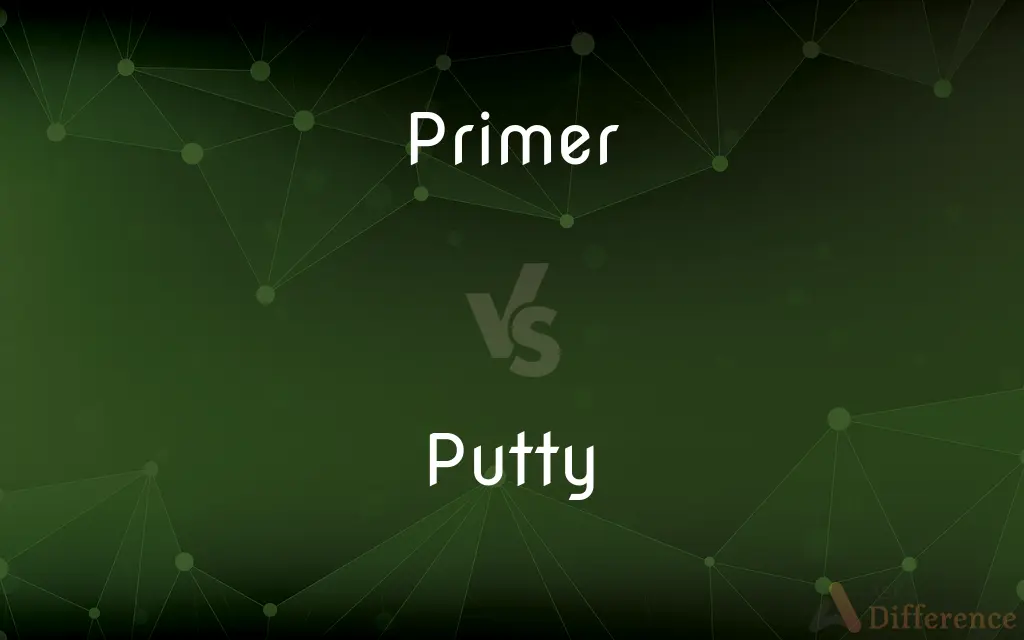Primer vs. Putty — What's the Difference?
By Fiza Rafique & Urooj Arif — Updated on March 11, 2024
Primer is a preparatory coating applied to materials before painting to ensure better adhesion and durability, whereas putty is a malleable substance used to fill in holes, cracks, or gaps in surfaces.

Difference Between Primer and Putty
Table of Contents
ADVERTISEMENT
Key Differences
Primer is essential in painting processes to create a smooth, uniform surface that enhances the paint's adherence and prolongs its lifespan. It's designed to prevent common issues like peeling, blistering, and staining. Putty, on the other hand, is mainly used for repair and sealing tasks, providing a smooth surface by filling imperfections before any finishing, like painting, is applied.
While primer is applied as a preliminary coat to the entire surface to be painted, ensuring a consistent and protective base for subsequent paint layers, putty is used more selectively, targeting specific areas that require filling or leveling. The application of putty is usually followed by sanding to achieve a smooth finish, which can then be primed or painted over.
The composition of primers can vary widely depending on the type of surface they are intended for, such as wood, metal, or drywall, and they may have additional properties like rust inhibition or moisture resistance. Putty's composition is designed for pliability and ease of application to fill voids and can vary based on the type of surface it is intended for and the specific repair needs.
Despite their different primary purposes, both primer and putty play crucial roles in surface preparation, ensuring that the final paint job or finish is smooth, durable, and visually appealing. They complement each other in the preparation process, with putty addressing surface irregularities and primer ensuring optimal paint adhesion and finish quality.
Comparison Chart
Purpose
Enhances paint adhesion and durability.
Fills in holes, cracks, or gaps in surfaces.
ADVERTISEMENT
Application
Applied as a base coat to the entire surface.
Used selectively on imperfections.
Composition
Varies by intended surface (e.g., wood, metal).
Typically pliable, varies by repair needs.
Additional Properties
May include rust inhibition, moisture resistance.
Designed for ease of application and sanding.
Role in Surface Preparation
Creates a uniform surface for painting.
Smooths out surface irregularities.
Compare with Definitions
Primer
A preparatory coat for painting.
The carpenter applied primer to the wood before painting.
Putty
A substance for filling surface imperfections.
He used putty to fill the nail holes in the wall.
Primer
Prevents paint issues.
The primer was used to avoid peeling and blistering of the paint.
Putty
Used to seal gaps or cracks.
Window frames were sealed with putty to prevent drafts.
Primer
Enhances paint adhesion.
Using primer ensures the paint sticks better to the surface.
Putty
Malleable for easy application.
The putty was soft and easy to mold into the gaps.
Primer
Specially formulated for various surfaces.
She chose a primer specifically designed for metal.
Putty
Requires sanding for a smooth finish.
After the putty dried, it was sanded down smoothly.
Primer
Can have additional protective properties.
The primer also served as a rust inhibitor for the outdoor furniture.
Putty
Can vary in composition based on use.
The plumber used a special putty for sealing pipes.
Primer
A substance used as a preparatory coat on wood, metal, or canvas, especially to prevent the absorption of subsequent layers of paint or the development of rust
Apply three coats of primer
New plaster should be treated with a primer
Putty
Putty is a material with high plasticity, similar in texture to clay or dough, typically used in domestic construction and repair as a sealant or filler. Although some types of putty (typically those using linseed oil) slowly polymerise and become stiff, many putties can be reworked indefinitely, in contrast to other types of filler which typically set solid relatively rapidly.
Primer
A cap or cylinder containing a compound which responds to friction or an electrical impulse and ignites the charge in a cartridge or explosive
The nitro-cellulose is ignited by the spark that comes from the primer
Putty
A doughlike cement made by mixing whiting and linseed oil, used to fill holes in woodwork and secure panes of glass.
Primer
A small pump for pumping fuel to prime an internal combustion engine, especially in an aircraft
No more than four pumps of the primer usually suffice
Putty
A substance with a similar consistency or function.
Primer
A molecule that serves as a starting material for a polymerization process
The duplex RNA primer cannot initiate DNA replication
Putty
A fine lime cement used as a finishing coat on plaster.
Primer
An elementary textbook that serves as an introduction to a subject of study or is used for teaching children to read
A first-year philosophy primer
Putty
A yellowish or light brownish gray to grayish yellow or light grayish brown.
Primer
An elementary textbook for teaching children to read.
Putty
To fill, cover, or secure with putty.
Primer
A book that covers the basic elements of a subject.
Putty
A form of cement, made from linseed oil and whiting, used to fix panes of glass.
Primer
A cap or tube containing a small amount of explosive used to detonate the main explosive charge of a firearm or mine.
Putty
Any of a range of similar substances.
Primer
An undercoat of paint or size applied to prepare a surface, as for painting.
Putty
An oxide of tin, or of lead and tin, used in polishing glass, etc.
Primer
(Genetics) A segment of DNA or RNA that is complementary to a given DNA sequence and that is needed to initiate replication by DNA polymerase.
Putty
A fine cement of lime only, used by plasterers.
Primer
A prayer or devotional book intended for laity, initially an abridgment of the breviary and manual including the hours of the Virgin Mary, 15 gradual and 7 penitential psalms, the litany, the placebo and dirige forming the office of the dead, and the commendations.
Putty
A golf ball made of composition and not gutta-percha.
Primer
Any of various similar works issued in England for private prayer in accordance with the Book of Common Prayer.
Putty
Of, pertaining to, or resembling putty.
Primer
A children's book intended to teach literacy: how to read, write, and spell.
Putty
(transitive) To fix or fill using putty.
Primer
An introductory text on any subject, particularly basic concepts.
Putty
A kind of thick paste or cement compounded of whiting, or soft carbonate of lime, and linseed oil, when applied beaten or kneaded to the consistence of dough, - used in fastening glass in sashes, stopping crevices, and for similar purposes.
Primer
(New Zealand) An elementary school class; an elementary school student. (No longer used.)
Putty
A ball made of composition and not gutta percha.
Primer
Any substance or device, such as priming wire or blasting cap, used to ignite gunpowder or other explosive.
Putty
A kind of gaiter of waterproof cloth wrapped around the leg, used by soldiers, etc.
Primer
A person who primes explosives.
Putty
To cement, or stop, with putty.
Primer
A substance used to prime wood, metal, etc. in preparation for painting.
Putty
A dough-like mixture of whiting and boiled linseed oil; used especially to patch woodwork or secure panes of glass
Primer
A layer of such a substance.
Putty
Apply putty in order to fix or fill;
Putty the window sash
Primer
A layer of makeup that goes beneath the foundation; undermakeup.
Primer
A person who primes wood, metal, etc.
Primer
A molecule which initiates the synthesis of an enzyme, (especially) a single-stranded nucleic acid molecule which initiates DNA replication.
Primer
A pheromone which interacts first with the endocrine system.
Primer
A device used to prime an internal combustion engine with gasoline, (especially) in airplanes.
Primer
A person who prunes trees.
Primer
(obsolete) First in time, initial, early.
Primer
(obsolete) First in importance, premier.
Primer
First in position, foremost.
Primer
One who, or that which, primes
Primer
Originally, a small prayer book for church service, containing the little office of the Virgin Mary; also, a work of elementary religious instruction.
The primer, or office of the Blessed Virgin.
Primer
A small elementary book for teaching children to read; a reading or spelling book for a beginner.
As he sat in the school at his prymer.
Primer
A kind of type, of which there are two species; one, called long primer, intermediate in size between bourgeois and small pica [see Long primer]; the other, called great primer, larger than pica.
Primer
First; original; primary.
Primer
An introductory textbook
Primer
Any igniter that is used to initiate the burning of a propellant
Primer
The first or preliminary coat of paint or size applied to a surface
Common Curiosities
Is putty necessary if I use a primer?
Putty is used for filling imperfections; if the surface has such issues, it's advisable to use putty before priming.
Can I use exterior primer indoors?
While possible, it's best to use primers designed for the specific conditions and surfaces of your project.
Can I paint directly over putty?
It's recommended to prime over putty after sanding for a smoother, more durable finish.
Do all primers work on every surface?
Primers are formulated for specific surfaces, so it's important to choose one suitable for your material.
Can putty prevent leaks?
Some types of putty are designed for sealing and can prevent leaks, depending on the application.
Can primer be used as putty?
No, primer is not designed to fill gaps or imperfections like putty.
How thick should I apply putty?
Apply putty thick enough to fill the imperfection without excess; it can be sanded down to level.
How long should I wait after applying putty to apply primer?
Wait for the putty to fully dry, which can vary by product, before applying primer.
Are there different types of primer for different paint types?
Yes, there are primers formulated for compatibility with various paint types, such as oil-based or latex.
Does putty shrink as it dries?
Some types of putty may shrink slightly; it may be necessary to apply a second coat.
Is it necessary to sand putty before priming?
Yes, sanding putty creates a smooth surface that's ideal for priming and painting.
Can I use putty on wet surfaces?
Most putties require a dry surface for proper adhesion; check the product's specifications.
How long does primer take to dry?
Drying times vary by product and conditions; refer to the manufacturer's instructions.
Can primer be tinted?
Yes, some primers can be tinted to closely match the color of the topcoat.
How do I know if I need to use putty?
Inspect the surface for any gaps, cracks, or holes that might need filling for a smooth finish.
Share Your Discovery

Previous Comparison
Compose vs. Draft
Next Comparison
Android vs. LinuxAuthor Spotlight
Written by
Fiza RafiqueFiza Rafique is a skilled content writer at AskDifference.com, where she meticulously refines and enhances written pieces. Drawing from her vast editorial expertise, Fiza ensures clarity, accuracy, and precision in every article. Passionate about language, she continually seeks to elevate the quality of content for readers worldwide.
Co-written by
Urooj ArifUrooj is a skilled content writer at Ask Difference, known for her exceptional ability to simplify complex topics into engaging and informative content. With a passion for research and a flair for clear, concise writing, she consistently delivers articles that resonate with our diverse audience.















































